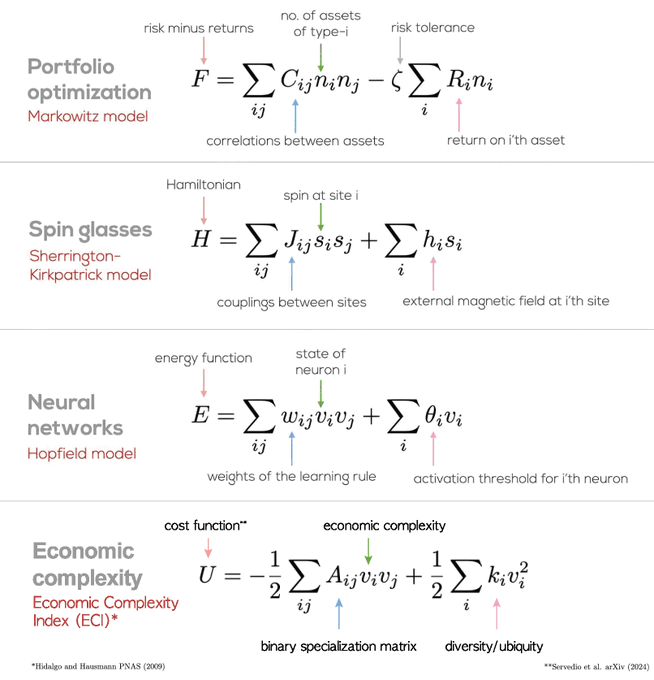- Apr 2025
-
www.theguardian.com www.theguardian.com
- Oct 2024
-
x.com x.com
-
The similarity is because they are all saying roughly the same thing: Total (result) = Kinetic (cost) + Potential (benefit) Cost is either imaginary squared or negative (space-like), benefit is real (time-like), result is mass-like. Just like physics, the economic unfavourable models are the negative results. In economics, diversity of products is a strength as it allows better recovery from failure of any one, comically DEI of people fails miserably at this, because all people are not equal. Here are some other examples you will know if you do physics: E² + (ipc)² = (mc²)² (relativistic Einstein equation), mass being the result, energy time-like (potential), momentum the space-like (kinetic). ∇² - 1/c² ∂²/∂t² = (mc/ℏ)² (Klein-Gordon equation), mass is the result, ∂²/∂t² potential, ∇² is kinetic. Finally we have Dirac equation, which unlike the previous two as "sum of squares" is more like vector addition (first order differentials, not second). iℏγ⁰∂₀ψ + iℏγⁱ∂ᵢψ = mcψ First part is still the time-like potential, second part is the space-like kinetic, and the mass is still the result though all the same. This is because energy is all forms, when on a flat (free from outside influence) worksheet, acts just like a triangle between potential, kinetic and resultant energies. E.g. it is always of the form k² + p² = r², quite often kinetic is imaginary to potential (+,-,-,-) spacetime metric, quaternion mathematics. So the r² can be negative, or imaginary result if costs out way benefits, or work in is greater than work out. Useless but still mathematical solution. Just like physics, you always want the mass or result to be positive and real, or your going to lose energy to the surrounding field, with negative returns. Economic net loss do not last long, just like imaginary particles in physics.
in reply to Cesar A. Hidalgo at https://x.com/realAnthonyDean/status/1844409919161684366
via Anthony Dean @realAnthonyDean
-
- Oct 2023
-
www.theguardian.com www.theguardian.com
-
Die Extremwetter-Ereignisse dieses Jahres entsprechen den Vorhersagen der Klimawissenschaft. Der Guardian hat dazu zahlreichende Forschende befragt und viele Statements in einem multimedialen Artikel zusammengestellt. Alle Befragten stimmen darin überein, dass die Verbrennung fossiler Brennstoffe sofort beendet werden muss, um eine weitere Verschlimmerung zu stoppen. Festgestellt wird auch, dass die Verwundbarkeit vieler Communities bisher unterschätzt worden ist. https://www.theguardian.com/environment/2023/aug/28/crazy-off-the-charts-records-has-humanity-finally-broken-the-climate
Tags
- expert: Emily Shuckburgh
- expert: Raúl Cordero
- expert: Friederike Otto
- expert: Marshall Shepherd
- expert: Andrea Dutton
- expert: Michael Mann
- expert: Sarah Perkins-Kirkpatrick
- expert: Paola Arias
- expert: Swapna Panickal
- expert: Marcos Andrade
- expert: Natalie Mahowald
- expert: Pep Canadell
- expert: Eliseu Aquino
- time: 2033
- expert: Piers Forster
- expert: Tim Palmer
- expert: Joseph Mutemi
- expert: Rein Haarsma
- expert: Vincent Ajayi
- expert: Christophe Cassou
- expert: Jana Willmann
- expert: Matthew England
- expert: Katharine Hayhoe
- process: increasing risk of extreme weather
- expert: Julie Arblaster
- expert: Hugo Hidalgo
- expert: Malte Meinshausen
- expert: Shaina Sadai
- expert: Suruchi Bhadwal
- process: global heating
- NGO: Union of Concerned Scientists
- expert: Mika Rantanen
- institution: Nature Conservancy
- expert: Krishna AchutaRao
Annotators
URL
-
- Jul 2023
-
www.reuters.com www.reuters.com
-
Der Juni war ein Monat der Temperaturrekorde und Hitzewellen in vielen Ländern der Welt und großen Teilen der Ozeane. Sie können Signale von Entwicklungen sein, die noch bedrohlicher sind, als es sich aus den vorhandenen Modellierungen ergibt. Reuters berichtet zusammenfassend über diese Entwicklungen und über den von Klimawissenschaftler:innen und NGOs festgestellten Stillstand bei den verschiedenen internationalen Klimaverhandlungen.
-
- Jun 2022
-
thrivingonoverload.com thrivingonoverload.com
-
Marshall’s method for connecting which he calls Triangle Thinking (26:41)
Marshall Kirkpatrick describes a method of taking three ostensibly random ideas and attempting to view each from the others' perspectives as a way to create new ideas by linking them together.
This method is quite similar to that of Raymond Llull as described in Frances Yate's The Art of Memory (UChicago Press, 1966), though there Llull was memorizing and combinatorially permuting 20 or more ideas at a time. It's also quite similar to the sort of meditative practice found in the lectio divina, though there ideas are generally limited to religious ones for contemplation.
https://content.blubrry.com/thrivingonoverload/THRIVING_013_Marshall_Kirkpatrick.mp3#t=1559,1745
Other examples: - https://hypothes.is/users/chrisaldrich?q=%22combinatorial+creativity%22 - https://hypothes.is/users/chrisaldrich?q=%22Llullan%20combinatorial%20arts%22
-
- Mar 2019
-
-
Jack Phillips and ROI. This page describes the Phillips Return on Investment model. The model as presented here is an alternative to Kirkpatrick's model. There's a bulleted list of the components of the model as well as a nice graphic that briefly describes the levels. There is an explanation about how to apply the model, though I think more information would be needed for real world practice. Rating 4/5
-
